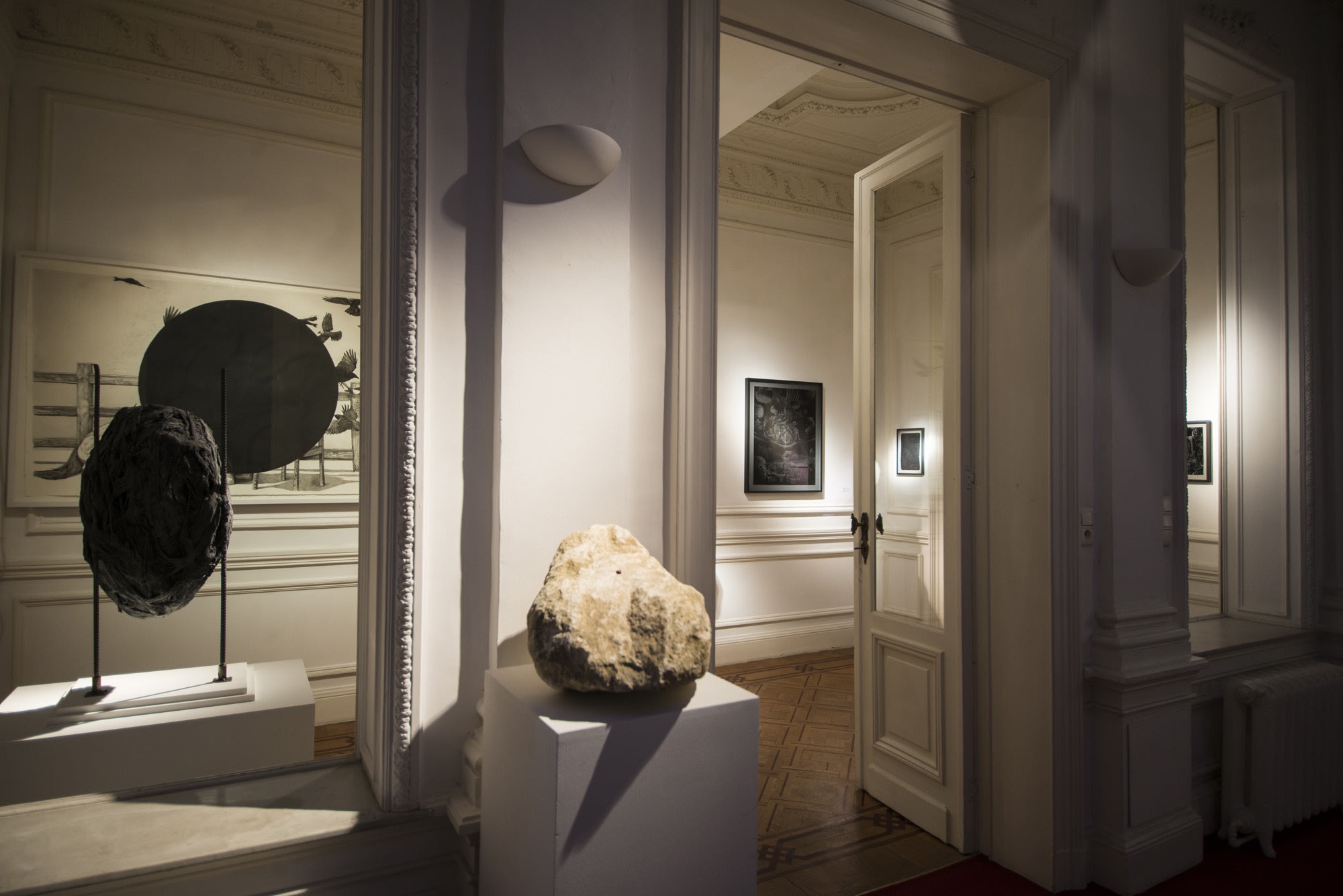
Prememories
19 February - 24 April 2016
Aeroplastics @ Rue Blanche Str., Brussels
Group exhibition with works by :
ELODIE ANTOINE - MEGHAN BOODY - KATIA BOURDAREL - CHARLEY CASE - TOM DALE - TILL FREIWALD - ECKART HAHN - DIONISIS KAVALLIERATOS - ALEXANDRA LEYRE-MEIN - ROBERT MCNALLY - TILL RABUS - SAMUEL ROUSSEAU - MARK TITCHNER - KATE WATERS - JASON BARD YARMOSKY
Prememories groups works and artists that all play at expanding the frontiers of reality, progressively encroaching new ground of the imaginary, dreams or nightmares through their process.
A priori, nothing looks more anchored in the concrete world than an eighty-kilo rock, except perhaps when Tom Dale kits it with a flashing red LED to indicate that it is on standby - but for what? This distortion of reality can be found in his odd and ample inflatable structures, or more allegorically, in his series of Russian dolls marked with the symbols of monetary currencies. With her "tactile" cushions, bath and beach towels, Elodie Antoine plays with the same ambiguity, and her reworked everyday objects remain strangely familiar despite the changes she brings. Till Rabus transforms well-known characters by drenching them in a thick, uniform coat of white paint, or still, "eroticises" an unassuming pile of branches: here again, the artist exploits the triteness of everyday objects.
Jason Bard Yarmosky treats everyday life by making portraits of his grandparents. Although he adores them, he has no misgivings cloaking them out in various disguises, emphasizing the contrast between their old age and young spirit. Katia Bourdarel takes her inspiration from her two children, who she has almost exclusively painted these past few years. Her works fall into a hyperrealist vein that reflects her passion for a medium that she masters perfectly, whereas her watercolours veer towards the oneiric and imaginary. Meghan Boody's photographs also evoke an otherworldly universe, epitomizing fragments of the complex relation of the female figure with the world.
The uncertain relationship between painting and reality rests at the core of Kate Waters' work as the artist explores the aesthetics of mass photography. The challenge she faces does not consist in reproducing perfection, but rather in flawlessly replicating the imperfections of an originally clichéd image on a huge canvas. The theme of format is also crucial for Till Freiwald. The close-up watercolour portraits of her models spread out onto 2-meters sheets of paper whereas the technique is usually associated with small works. The contrast between the monumentality of the images and the realism of the faces confer the latter a simultaneously imposing and delicate aspect. Unlike Till Freiwald, Robert McNally exclusively works from memory, from which he wrenches seemingly unrelated images that he assembles in extremely detailed compositions conjuring dreams or nightmares. His technique consists in drawing with a pencil with an uncommon mastery on a very specific paper sometimes used for space photography and known for its high light absorbency qualities. Pencil on paper and sculpture are Dionisis Kavallieratos' medium of choice. His pieces indifferently mingle historical references, folk culture, the Antiquity or still, politics, like so many elements of a personal mythology of which The Old Bordello could very well be the temple. In the work of Eckart Hahn, composition often centres on very few elements. Describing his work as a sort of "broken realism", the artist plays on the reproduction of complex three-dimensional forms with an almost-surreal accuracy. In Alexandra Leyre Mein's sculptures, reality is nothing more than a distant memory that only survives through shapes animated by a strong internal tension and made up of natural, organic materials.
Charley Case pursues his exploration of the human face as symbol of an otherness that would guarantee the belonging to the human race. Conversely, Mark Titchner reflects - with great humour - on the obsession of individualism characterizing today's societies. "Prememories" undeniably evokes the world of dreams, memories and abnormality to better send us back to our reality. In an era when the destruction of collective knowledge is the clearly stated objective of international terrorism, it is more crucial to preserve our shared memory than ever before. But in the works of Samuel Rousseau, that memory escapes from the books destined to preserve it.
PY Desaive, Brussels











